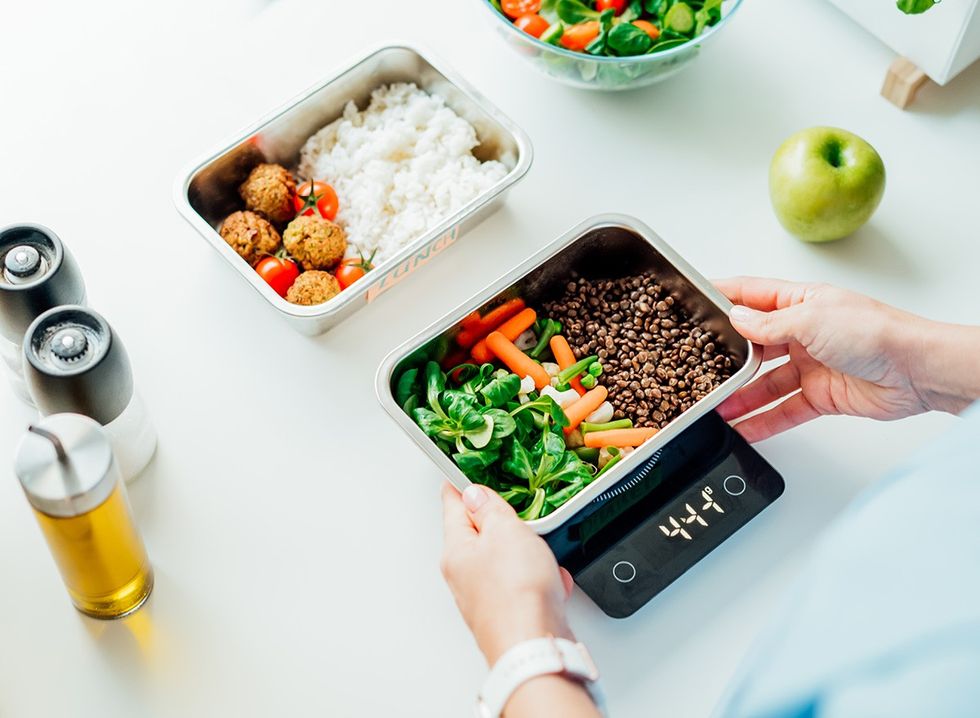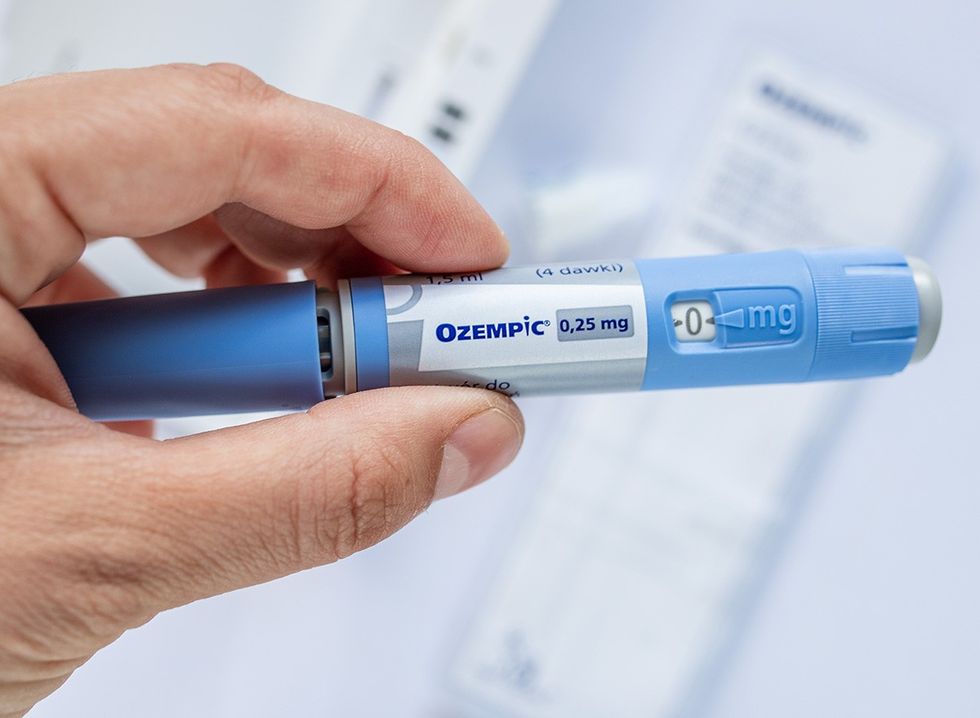Do you want to lose weight and look younger? Dr. Fay Kazzi is a registered dietician with an extensive background in nutrition and dietetics who has a PhD in rehabilitation science. “From the age of 35 and on, when it comes to stubborn weight, the usual weight loss fixes like caloric deficit and exercise might not be as helpful as they used to be, which is why I'm here to help you guys out,” she says at the start of the clip. As part of her “Age Gracefully Nutrition” series, she goes on to explain why you need to change your approach to weight loss as you get older and reveals her top three “weight loss hacks.”
Weight Management Gets Challenging As You Age
“You have that one friend that always seemed to have been on the heavier side, and then some time goes by, you don't see them for a while, and then you see them again. But something has changed. They've lost a significant amount of weight like we're talking about 15 or 20 pounds, and then the first thing that you notice is, wow, they look so much younger. So yes, weight loss not only improves your metabolic health, but it also makes you appear younger, healthier, and more vibrant,” she says in the post. “Why does weight management get a bit more challenging after 35? Here are three possible reasons,” she says.
You Experience Metabolic Decline at 35
“Number one, natural metabolic decline around the age of 35,” she reveals. “A woman's metabolic rate tends to slow down due to natural changes in muscle mass and hormonal shifts. The lean muscle mass, which burns more calories than fat tissue, naturally declines with age. A 2021 study in the Journal of Science found that the metabolic rate slows down approximately one to 2 percent per decade after the age of 30, meaning fewer calories are burned at rest than when you're younger. So you could basically just sit around and do nothing, and your body would burn calories when you were a teenager and in your twenties. This gradual reduction makes it easier to gain weight and harder to lose it without adjusting caloric intake and increasing our physical activity, which is another reason why building muscle is so important in your late thirties.”
You Also Experience Hormonal Changes
“Number two reason, hormonal changes, and insulin sensitivity,” she continues. “Hormonal fluctuations, especially around perimenopause, which can start as early as your late thirties, can significantly impact your weight loss. So estrogen, which influences where the body fat is stored, starts to decline, often resulting in more abdominal fat storage. I know it's the worst, and as we all know, it's harder to lose. So additionally, a decline in estrogen can contribute to reduced insulin sensitivity, which can lead to higher blood sugar levels and then increased fat storage. Research in the Journal of Clinical Endocrinology and Metabolism highlights that even slight changes in estrogen levels can increase body fat, particularly, unfortunately, again in the abdominal area.”
RELATED: Nurse Lost 80 Pounds in 5 Months by Doing These 5 Things
And, Lifestyle Demands and Stress Levels Usually Increase
“Number three reason is lifestyle demands and stress levels,” she continues. “Women in their late thirties often juggle careers and family responsibilities and other social demands, which can lead to increased stress and disrupted sleep patterns. So, both stress and lack of sleep can raise your cortisol levels, a hormone that's associated with increased appetite and fat storage. Again, it goes to the abdominal area. A 2018 study in the Journal of Obesity found that higher cortisol levels were linked to weight gain, especially in midlife women, due to the stress of balancing various life demands. So this can make weight loss especially harder despite the diet restrictions and exercise efforts.”
However, There Are Things You Can Do to Mitigate the Effects
However, there are things you can do. “Even though these factors combined can make weight loss after 35 more challenging with targeted strategies, it is possible to mitigate these effects. There are ways, and there are paths. There are three things you can start doing today to lose weight and keep it off,” she says.
First, Increase Your Protein Intake
“Number one, increase your intake of protein per meal,” she suggests. “This is such a game changer. If you're a woman and you're in your late thirties, you absolutely have to start building all of your meals around protein, not carbohydrates. Depending on your activity level, you need about 0.8 to 1.2 grams of protein per kilogram of weight. So if you're, say, 125 pounds, that's about 57 kilograms, so roughly about 45 to 50 grams of protein, you want to split that throughout the day. So about 20 to 25 grams of protein per meal, and this is totally doable.” She points out that one cup of Greek yogurt is 20 grams, half a cup of ground turkey is about 20 grams, half a cup of tofu is about 20 grams, and one cup of lentils is about 20 grams. “The reason increasing protein helps is because it boosts the metabolism. It preserves lean muscle mass, and it makes you feel full, reducing your appetite. So how does that work? Protein increases the production of satiety hormones, glucagon-like peptide one cholecystokinin, while reducing, reducing the production of hunger hormones such as ghrelin.”
RELATED: 8 Diet Tips to Lose Weight, According to Coach
Second, Narrow Your Eating Window
“Number two, narrow your eating window,” she suggests. “By now, for sure, you've probably heard a lot about intermittent fasting, time-restricted eating, and chrononutrition. Let me distill it for you. We really don't need to have three large meals spread throughout the day. Narrowing your eating window gives your body the ability to rest, rejuvenate itself, and set all of its metabolic ducks in order, so to speak. When you don't eat for a longer period of time, your body runs out of sugar and starts to burn fat for energy. This process is called metabolic switching. If you don't have any other underlying medical conditions, the general rule of thumb is to eat your day's calories within an eight-hour window, so have a late breakfast, let's say around 11:00 AM, and try to have your last meal before 6:00 PM. Also, when you stop eating earlier in the day, this is going to improve your sleep, which is also going to increase your metabolic health.”
Third, Increase Intake of High Quality Fat
Number three, increase your intake of high-quality fat. “I know this sounds so counterintuitive, but there's so much evidence right now that high-quality organic fats like cold pressed olive oil, grass-fed butter, raw nuts and seeds, the fat in free-range eggs, the fat and avocados, coconut cream, and kinds of milk are extremely satiating and nutrient dense and actually do not contribute to obesity,” she says. “It's been well established in research for decades now that one of the outcomes for epileptic patients who are put on a strict high fat, low carb diet as part of their treatment plan to manage their epileptic episodes is that these patients also lose weight by significantly reducing the carbohydrates. The body switches to burning fat for energy, which can result in weight loss, especially with that stubborn fat, but let's not get carried away. The recommendation for a generally healthy woman is to reduce the carbohydrates and increase the high-quality fats moderately.”
However, do not confuse this with overly processed, poor-quality fats like seed oils and their hydrogenated byproducts. “These include canola oil, corn oil, safflower oil, vegetable oil, soybean oil, and margarine, which are all in most processed foods such as your pastries, your chips, and your canned soups. Yes, they are hiding in your canned soups, crackers, cookies, breakfast cereals, mixed nuts, and even some of the bread brands out there. These kinds of fats do the opposite. They have no nutritive value, and they're loaded with empty calories. They actually contribute to inflammation, which increases the retention of fat,” she says.
RELATED: Mum Lost 135 Pounds After Fixing These 6 Mistakes She Made Every Day
See Results in Just a Few Weeks
“These are three recommendations that you can start applying today to see a dramatic and sustained difference in your weight loss journey in just a few weeks. Of course, practices like regular exercise, decreasing your intake of, let's say, sugary beverages, and decreasing your stress levels will also assist with healthy and maintained weight loss,” she concludes. And if you enjoyed this article, take advantage of these 15 Quick Ways to Lose Body Fat Percentage in a Week.
















 She Tried “Literally Everything” to Lose 15 Pounds at 50Copyright michaelabentley_fitness/Instagram
She Tried “Literally Everything” to Lose 15 Pounds at 50Copyright michaelabentley_fitness/Instagram Once She Became a Personal Trainer She Figured Out What WorkedCopyright michaelabentley_fitness/Instagram
Once She Became a Personal Trainer She Figured Out What WorkedCopyright michaelabentley_fitness/Instagram

 Food Journaling and TrackingCopyright michaelabentley_fitness/Instagram
Food Journaling and TrackingCopyright michaelabentley_fitness/Instagram Moving MoreCopyright michaelabentley_fitness/Instagram
Moving MoreCopyright michaelabentley_fitness/Instagram

 I'm a Nutritionist and These 9 High-Protein Snacks Keep My Clients Full While Losing 50 Pounds
I'm a Nutritionist and These 9 High-Protein Snacks Keep My Clients Full While Losing 50 Pounds
 Shutterstock
Shutterstock 2. Processed FoodsShutterstock
2. Processed FoodsShutterstock Shutterstock
Shutterstock Shutterstock/Prostock-studio
Shutterstock/Prostock-studio Shutterstock
Shutterstock Pro TipsShutterstock
Pro TipsShutterstock Shutterstock
Shutterstock Shutterstock
Shutterstock Shutterstock
Shutterstock Shutterstock
Shutterstock Don’t Drink as Much AlcoholShutterstock
Don’t Drink as Much AlcoholShutterstock Most Women on GLP-1s Are Making a Few Common MistakesShutterstock
Most Women on GLP-1s Are Making a Few Common MistakesShutterstock Soda and Sugary DrinksShutterstock
Soda and Sugary DrinksShutterstock Shutterstock
Shutterstock Eat BreakfastShutterstock
Eat BreakfastShutterstock And Improve Insulin SensitivityShutterstock
And Improve Insulin SensitivityShutterstock Belly Flab Strip Tip: Sugar and Fat Calories Leave Its Mark on Your BodyShutterstock
Belly Flab Strip Tip: Sugar and Fat Calories Leave Its Mark on Your BodyShutterstock Shutterstock
Shutterstock The Drugs Mimic the GLP-1 Hormone Naturally Produced by the BodyShutterstock
The Drugs Mimic the GLP-1 Hormone Naturally Produced by the BodyShutterstock 3. Deep-Fried ItemsShutterstock
3. Deep-Fried ItemsShutterstock